18. The only way to approach the contemplation of Christ's face is by listening in the Spirit to the Father's voice, since “no one knows the Son except the Father” (Mt 11:27). In the region of Caesarea Philippi, Jesus responded to Peter's confession of faith by indicating the source of that clear intuition of his identity: “Flesh and blood has not revealed this to you, but my Father who is in heaven” (Mt 16:17). What is needed, then, is a revelation from above. In order to receive that revelation, attentive listening is indispensable: “Only the experience of silence and prayer offers the proper setting for the growth and development of a true, faithful and consistent knowledge of that mystery” (Apostolic Letter Novo Millennio ineunte, n. 20).
The Rosary is one of the traditional paths of Christian prayer directed to the contemplation of Christ's face. Pope Paul VI described it in these words: “As a Gospel prayer, centred on the mystery of the redemptive Incarnation, the Rosary is a prayer with a clearly Christological orientation. Its most characteristic element, in fact, the litany- like succession of Hail Marys, becomes in itself an unceasing praise of Christ, who is the ultimate object both of the Angel's announcement and of the greeting of the Mother of John the Baptist: 'Blessed is the fruit of your womb' (Lk 1:42). We would go further and say that the succession of Hail Marys constitutes the warp on which is woven the contemplation of the mysteries. The Jesus that each Hail Mary recalls is the same Jesus whom the succession of mysteries proposes to us now as the Son of God, now as the Son of the Virgin” (Marialis Cultus, n. 46).
19. Of the many mysteries of Christ's life, only a few are indicated by the Rosary in the form that has become generally established with the seal of the Church's approval. The selection was determined by the origin of the prayer, which was based on the number 150, the number of the Psalms in the Psalter.
I believe, however, that to bring out fully the Christological depth of the Rosary it would be suitable to make an addition to the traditional pattern which, while left to the freedom of individuals and communities, could broaden it to include the mysteries of Christ's public ministry between his Baptism and his Passion. In the course of those mysteries we contemplate important aspects of the person of Christ as the definitive revelation of God. Declared the beloved Son of the Father at the Baptism in the Jordan, Christ is the one who announces the coming of the Kingdom, bears witness to it in his works and proclaims its demands. It is during the years of his public ministry that the mystery of Christ is most evidently a mystery of light: “While I am in the world, I am the light of the world” (Jn 9:5).
Consequently, for the Rosary to become more fully a “compendium of the Gospel”, it is fitting to add, following reflection on the Incarnation and the hidden life of Christ (the joyful mysteries) and before focusing on the sufferings of his Passion (the sorrowful mysteries) and the triumph of his Resurrection (the glorious mysteries), a meditation on certain particularly significant moments in his public ministry (the mysteries of light). This addition of these new mysteries, without prejudice to any essential aspect of the prayer's traditional format, is meant to give it fresh life and to enkindle renewed interest in the Rosary's place within Christian spirituality as a true doorway to the depths of the Heart of Christ, ocean of joy and of light, of suffering and of glory.
20. The first five decades, the “joyful mysteries”, are marked by the joy radiating from the event of the Incarnation. This is clear from the very first mystery, the Annunciation, where Gabriel's greeting to the Virgin of Nazareth is linked to an invitation to messianic joy: “Rejoice, Mary”. The whole of salvation history, in some sense the entire history of the world, has led up to this greeting. If it is the Father's plan to unite all things in Christ (cf. Eph 1:10), then the whole of the universe is in some way touched by the divine favour with which the Father looks upon Mary and makes her the Mother of his Son. The whole of humanity, in turn, is embraced by the fiat with which she readily agrees to the will of God.
Exultation is the keynote of the encounter with Elizabeth, where the sound of Mary's voice and the presence of Christ in her womb cause John to “leap for joy” (cf. Lk 1:44). Gladness also fills the scene in Bethlehem, when the birth of the divine Child, the Saviour of the world, is announced by the song of the angels and proclaimed to the shepherds as “news of great joy” (Lk 2:10).
The final two mysteries, while preserving this climate of joy, already point to the drama yet to come. The Presentation in the Temple not only expresses the joy of the Child's consecration and the ecstasy of the aged Simeon; it also records the prophecy that Christ will be a “sign of contradiction” for Israel and that a sword will pierce his mother's heart (cf Lk 2:34-35). Joy mixed with drama marks the fifth mystery, the finding of the twelve-year-old Jesus in the Temple. Here he appears in his divine wisdom as he listens and raises questions, already in effect one who “teaches”. The revelation of his mystery as the Son wholly dedicated to his Father's affairs proclaims the radical nature of the Gospel, in which even the closest of human relationships are challenged by the absolute demands of the Kingdom. Mary and Joseph, fearful and anxious, “did not understand” his words (Lk 2:50).
To meditate upon the “joyful” mysteries, then, is to enter into the ultimate causes and the deepest meaning of Christian joy. It is to focus on the realism of the mystery of the Incarnation and on the obscure foreshadowing of the mystery of the saving Passion. Mary leads us to discover the secret of Christian joy, reminding us that Christianity is, first and foremost, euangelion, “good news”, which has as its heart and its whole content the person of Jesus Christ, the Word made flesh, the one Saviour of the world.
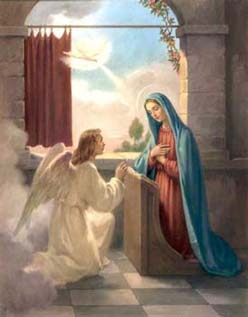 The First Joyful Mystery: The First Joyful Mystery:The Annunciation |
 Second Joyful Mystery: Second Joyful Mystery:The Visitation |
 Third Joyful Mystery: Third Joyful Mystery:The Birth of Our Lord |
 Fourth Joyful Mystery: Fourth Joyful Mystery:The Presentation of the Child Jesus |
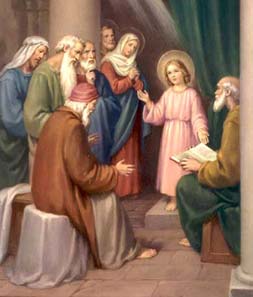 Fifth Joyful Mystery: Fifth Joyful Mystery:The Finding in the Temple |
21. Moving on from the infancy and the hidden life in Nazareth to the public life of Jesus, our contemplation brings us to those mysteries which may be called in a special way “mysteries of light”. Certainly the whole mystery of Christ is a mystery of light. He is the “light of the world” (Jn 8:12). Yet this truth emerges in a special way during the years of his public life, when he proclaims the Gospel of the Kingdom. In proposing to the Christian community five significant moments – “luminous” mysteries – during this phase of Christ's life, I think that the following can be fittingly singled out:
Each of these mysteries is a revelation of the Kingdom now present in the very person of Jesus. The Baptism in the Jordan is first of all a mystery of light. Here, as Christ descends into the waters, the innocent one who became “sin” for our sake (cf. 2Cor 5:21), the heavens open wide and the voice of the Father declares him the beloved Son (cf. Mt 3:17 and parallels), while the Spirit descends on him to invest him with the mission which he is to carry out.
Another mystery of light is the first of the signs, given at Cana (cf. Jn 2:1- 12), when Christ changes water into wine and opens the hearts of the disciples to faith, thanks to the intervention of Mary, the first among believers. Another mystery of light is the preaching by which Jesus proclaims the coming of the Kingdom of God, calls to conversion (cf. Mk 1:15) and forgives the sins of all who draw near to him in humble trust (cf. Mk 2:3-13; Lk 7:47- 48): the inauguration of that ministry of mercy which he continues to exercise until the end of the world, particularly through the Sacrament of Reconciliation which he has entrusted to his Church (cf. Jn 20:22-23).
The mystery of light par excellence is the Transfiguration, traditionally believed to have taken place on Mount Tabor. The glory of the Godhead shines forth from the face of Christ as the Father commands the astonished Apostles to “listen to him” (cf. Lk 9:35 and parallels) and to prepare to experience with him the agony of the Passion, so as to come with him to the joy of the Resurrection and a life transfigured by the Holy Spirit. A final mystery of light is the institution of the Eucharist, in which Christ offers his body and blood as food under the signs of bread and wine, and testifies “to the end” his love for humanity (Jn 13:1), for whose salvation he will offer himself in sacrifice.
In these mysteries, apart from the miracle at Cana, the presence of Mary remains in the background. The Gospels make only the briefest reference to her occasional presence at one moment or other during the preaching of Jesus (cf. Mk 3:31-5; Jn 2:12), and they give no indication that she was present at the Last Supper and the institution of the Eucharist. Yet the role she assumed at Cana in some way accompanies Christ throughout his ministry. The revelation made directly by the Father at the Baptism in the Jordan and echoed by John the Baptist is placed upon Mary's lips at Cana, and it becomes the great maternal counsel which Mary addresses to the Church of every age: “Do whatever he tells you” (Jn 2:5). This counsel is a fitting introduction to the words and signs of Christ's public ministry and it forms the Marian foundation of all the “mysteries of light”.
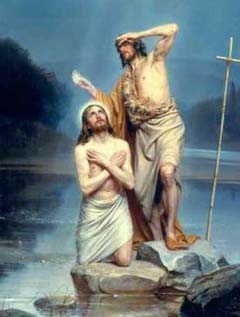 The First Luminous Mystery: The First Luminous Mystery:The Baptism of Jesus |
 Second Luminous Mystery: Second Luminous Mystery:The First Miracle of Jesus at the Wedding of Cana |
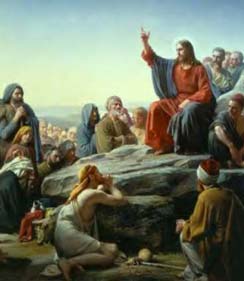 Third Luminous Mystery: Third Luminous Mystery:The Proclamation of the Kingdom of God and the call to conversion |
 Fourth Luminous Mystery: Fourth Luminous Mystery:The Transfiguration of Jesus |
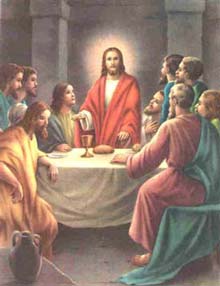 Fifth Luminous Mystery: Fifth Luminous Mystery:The institution of the Holy Eucharist |
22. The Gospels give great prominence to the sorrowful mysteries of Christ. From the beginning Christian piety, especially during the Lenten devotion of the Way of the Cross, has focused on the individual moments of the Passion, realizing that here is found the culmination of the revelation of God's love and the source of our salvation. The Rosary selects certain moments from the Passion, inviting the faithful to contemplate them in their hearts and to relive them. The sequence of meditations begins with Gethsemane, where Christ experiences a moment of great anguish before the will of the Father, against which the weakness of the flesh would be tempted to rebel. There Jesus encounters all the temptations and confronts all the sins of humanity, in order to say to the Father: “Not my will but yours be done” (Lk 22:42 and parallels). This “Yes” of Christ reverses the “No” of our first parents in the Garden of Eden. And the cost of this faithfulness to the Father's will is made clear in the following mysteries; by his scourging, his crowning with thorns, his carrying the Cross and his death on the Cross, the Lord is cast into the most abject suffering: Ecce homo!
This abject suffering reveals not only the love of God but also the meaning of man himself. Ecce homo: the meaning, origin and fulfilment of man is to be found in Christ, the God who humbles himself out of love “even unto death, death on a cross” (Phil 2:8). The sorrowful mysteries help the believer to relive the death of Jesus, to stand at the foot of the Cross beside Mary, to enter with her into the depths of God's love for man and to experience all its life-giving power.
 The First Sorrowful Mystery: The First Sorrowful Mystery:The Agony in the Garden |
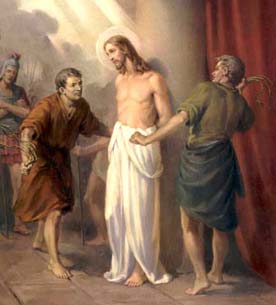 Second Sorrowful Mystery: Second Sorrowful Mystery:The scourging at the Pillar |
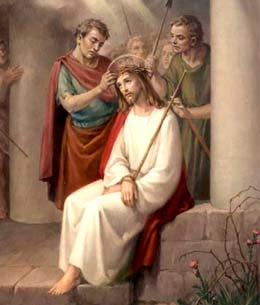 Third Sorrowful Mystery: Third Sorrowful Mystery:The Crowning with Thorns |
 Fourth Sorrowful Mystery: Fourth Sorrowful Mystery:Jesus carries His Cross |
 Fifth Sorrowful Mystery: Fifth Sorrowful Mystery:The Crucifixion |
23. “The contemplation of Christ's face cannot stop at the image of the Crucified One. He is the Risen One!” The Rosary has always expressed this knowledge born of faith and invited the believer to pass beyond the darkness of the Passion in order to gaze upon Christ's glory in the Resurrection and Ascension. Contemplating the Risen One, Christians rediscover the reasons for their own faith (cf. 1Cor 15:14) and relive the joy not only of those to whom Christ appeared – the Apostles, Mary Magdalene and the disciples on the road to Emmaus – but also the joy of Mary, who must have had an equally intense experience of the new life of her glorified Son. In the Ascension, Christ was raised in glory to the right hand of the Father, while Mary herself would be raised to that same glory in the Assumption, enjoying beforehand, by a unique privilege, the destiny reserved for all the just at the resurrection of the dead. Crowned in glory – as she appears in the last glorious mystery – Mary shines forth as Queen of the Angels and Saints, the anticipation and the supreme realization of the eschatological state of the Church.
At the centre of this unfolding sequence of the glory of the Son and the Mother, the Rosary sets before us the third glorious mystery, Pentecost, which reveals the face of the Church as a family gathered together with Mary, enlivened by the powerful outpouring of the Spirit and ready for the mission of evangelization. The contemplation of this scene, like that of the other glorious mysteries, ought to lead the faithful to an ever greater appreciation of their new life in Christ, lived in the heart of the Church, a life of which the scene of Pentecost itself is the great “icon”. The glorious mysteries thus lead the faithful to greater hope for the eschatological goal towards which they journey as members of the pilgrim People of God in history. This can only impel them to bear courageous witness to that “good news” which gives meaning to their entire existence.
 The First Glorious Mystery: The First Glorious Mystery:The Resurrection |
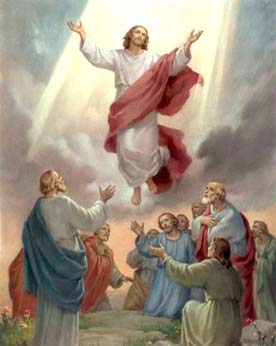 Second Glorious Mystery: Second Glorious Mystery:The Ascension of Our Lord |
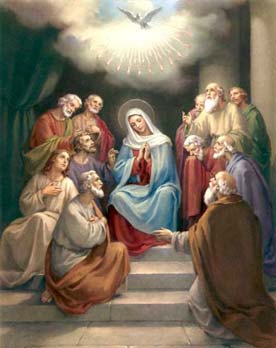 Third Glorious Mystery: Third Glorious Mystery:The Descent of the Holy Spirit |
 Fourth Glorious Mystery: Fourth Glorious Mystery:The Assumption of Mary |
 Fifth Glorious Mystery: Fifth Glorious Mystery:The Crowning of Mary |
24. The cycles of meditation proposed by the Holy Rosary are by no means exhaustive, but they do bring to mind what is essential and they awaken in the soul a thirst for a knowledge of Christ continually nourished by the pure source of the Gospel. Every individual event in the life of Christ, as narrated by the Evangelists, is resplendent with the Mystery that surpasses all understanding (cf. Eph 3:19): the Mystery of the Word made flesh, in whom “all the fullness of God dwells bodily” (Col 2:9). For this reason the Catechism of the Catholic Church places great emphasis on the mysteries of Christ, pointing out that “everything in the life of Jesus is a sign of his Mystery”.(30) The “duc in altum” of the Church of the third millennium will be determined by the ability of Christians to enter into the “perfect knowledge of God's mystery, of Christ, in whom are hidden all the treasures of wisdom and knowledge” (Col 2:2-3). The Letter to the Ephesians makes this heartfelt prayer for all the baptized: “May Christ dwell in your hearts through faith, so that you, being rooted and grounded in love, may have power... to know the love of Christ which surpasses knowledge, that you may be filled with all the fullness of God” (3:17-19).
The Rosary is at the service of this ideal; it offers the “secret” which leads easily to a profound and inward knowledge of Christ. We might call it Mary's way. It is the way of the example of the Virgin of Nazareth, a woman of faith, of silence, of attentive listening. It is also the way of a Marian devotion inspired by knowledge of the inseparable bond between Christ and his Blessed Mother: the mysteries of Christ are also in some sense the mysteries of his Mother, even when they do not involve her directly, for she lives from him and through him. By making our own the words of the Angel Gabriel and Saint Elizabeth contained in the Hail Mary, we find ourselves constantly drawn to seek out afresh in Mary, in her arms and in her heart, the “blessed fruit of her womb” (cf Lk 1:42).
25. In my testimony of 1978 mentioned above, where I described the Rosary as my favourite prayer, I used an idea to which I would like to return. I said then that “the simple prayer of the Rosary marks the rhythm of human life”.
In the light of what has been said so far on the mysteries of Christ, it is not difficult to go deeper into this anthropological significance of the Rosary, which is far deeper than may appear at first sight. Anyone who contemplates Christ through the various stages of his life cannot fail to perceive in him the truth about man. This is the great affirmation of the Second Vatican Council which I have so often discussed in my own teaching since the Encyclical Letter Redemptor Hominis: “it is only in the mystery of the Word made flesh that the mystery of man is seen in its true light”. The Rosary helps to open up the way to this light. Following in the path of Christ, in whom man's path is “recapitulated”, revealed and redeemed, believers come face to face with the image of the true man. Contemplating Christ's birth, they learn of the sanctity of life; seeing the household of Nazareth, they learn the original truth of the family according to God's plan; listening to the Master in the mysteries of his public ministry, they find the light which leads them to enter the Kingdom of God; and following him on the way to Calvary, they learn the meaning of salvific suffering. Finally, contemplating Christ and his Blessed Mother in glory, they see the goal towards which each of us is called, if we allow ourselves to be healed and transformed by the Holy Spirit. It could be said that each mystery of the Rosary, carefully meditated, sheds light on the mystery of man.
At the same time, it becomes natural to bring to this encounter with the sacred humanity of the Redeemer all the problems, anxieties, labours and endeavours which go to make up our lives. “Cast your burden on the Lord and he will sustain you” (Ps 55:23). To pray the Rosary is to hand over our burdens to the merciful hearts of Christ and his Mother. Twenty-five years later, thinking back over the difficulties which have also been part of my exercise of the Petrine ministry, I feel the need to say once more, as a warm invitation to everyone to experience it personally: the Rosary does indeed “mark the rhythm of human life”, bringing it into harmony with the “rhythm” of God's own life, in the joyful communion of the Holy Trinity, our life's destiny and deepest longing.
Contemplating Christ with Mary |
“For me, to live is Christ” |